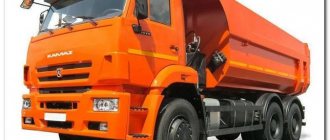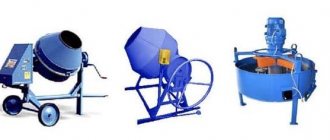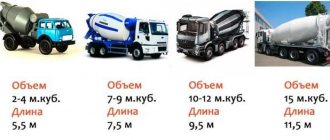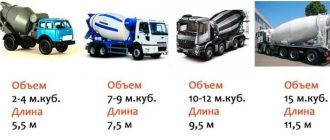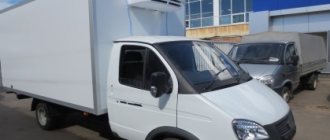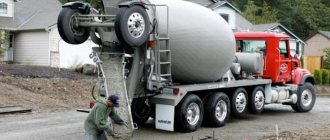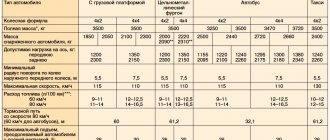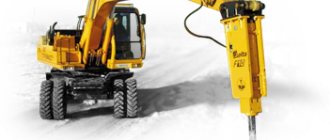- June 6, 2019
The need for building materials increases every year; everyone needs sand, crushed stone, and soil.
And the goods must be delivered in the required volume and on time. But not everyone knows how much material a machine can deliver, how much will it fit?
To do this, first of all, you need to know the carrying capacity of the car; this data is indicated in the documents for the car. Extended sides can be a plus; sometimes they do this to increase capacity.
Dimensions and volume of the body of various KamAZ models
Mechanical engineers produce several modifications of special equipment with distinctive characteristics, the main ones are listed in the table.
Parameters of various models of special equipment
| Brand | Load capacity, t. | volume, m3 | Length, mm | Width, mm | Height, mm |
| 43255/53605 | 7/7,2 | 6/6,5 | 6090/6650 | 2500 | 2920/2935 |
| 5511 | 10 | 6,6 | 4100 | 2500 | 1200 |
| 6522 | 13,4 | 12 | 7800 | 2500 | 3280 |
| 65111 | 14 | 8,2 | 7400 | 2500 | 31350 |
To make the right choice when ordering special equipment, it is not enough to know the dimensions of the body, as well as the amount of cargo being transported. It is also necessary to take into account the correspondence between cubic capacity and mass, which are individual in each specific case.
Loading and unloading
The sender, who carries out this work, is responsible for loading and securing the timber; the recipient is responsible for unloading and releasing the cargo from the fastenings. Loading and unloading occurs under the supervision of the supervisor of such work. During loading and unloading operations, the driver leaves his cab. But even in this case, it is prohibited to move loads above the vehicle cabin.
For transportation by road, logs are evenly distributed between bunks. The butts are leveled. The height of the load should not be greater than the stacked lumber at dismantling, more than 30 cm if logs are being removed, and 10 cm - assortment.
If a trailer is attached to the car, then the cargo senders couple the vehicles, and the driver controls the result. The coupler may perform work between the links of a road train only with the permission of the driver.
According to the rules, timber is accepted for transportation by road and handed over to the carrier by volume, and when transported in packages - by number of pieces. The sender indicates the volume, quantity and weight of wood in the consignment note; the latter indicator is calculated by calculation.
Cargoes are transported in bulk or packaged (lumber, round timber, products made from these raw materials). Regulations prohibit transporting packages if they are poorly or loosely tied or loosely packed. Valuable lumber is covered to protect it from precipitation. Unpackaged lumber is placed in stacks, which are separated by horizontal spacers and vertical posts. It is prohibited to overlap lumber and blanks.
Before removing the wood, strengthen the racks on both sides of the body sides. The struts on the side of the unloading are moved lower by two rows of materials as they are reduced and the racks are cut down. The struts on the other side are not touched until the end of unloading. The company providing services for road transportation of timber has the right to double-check the data specified in the document.
The process takes place mainly using special equipment - cranes, loaders and others, on which gripping devices are installed. Manual labor is rarely used. Then at least two loaders are involved, who use special accessories - strong ropes, slopes. Unloading large volumes is simplified if lumber is laid in several tiers, and cross beams are left between them. Rope slings can be easily threaded through such slots.
Before unloading begins, each stack is inspected, and the person in charge makes a decision on the team’s course of action. The safety of the cargo is ensured by proper stowage and fixation. To transport wood over long distances, it is treated with chemical compounds that protect against pests and microorganisms - mold, mildew, rot, etc. Loading and unloading work in this case is carried out only by mechanization. The driver should not take part in the process, unless the machines intended for this purpose are part of the car or installed on it. If necessary, the wood is covered with materials that protect the raw material from external factors, including climatic ones.
Types of dump trucks
Structurally, there are several types of equipment for transporting heavy construction materials, depending on the weight of the cargo:
- small – up to 2 tons;
- medium - up to 10 tons;
- heavy - up to 30 tons.
In the direction of unloading:
- lateral (left/right);
- back;
- 3-sided.
The second type of body is the most common, the third is more used in the agricultural sector for transporting crops.
According to body shape:
- rectangular;
- trough;
- ladle;
- scoop.
The main working brands are Zily, Mazy, with a carrying capacity of 4 - 8 tons, they are most often used to deliver cargo to the population. The weight parameters allow them to be used on any road, even in extreme heat. As a rule, they are used for transporting sand, earth, crushed stone, asphalt, and removal of construction and household waste.
During transportation, the fluidity of the cargo, its structure, and flowability must be taken into account, and then the body type is selected. A prerequisite for transportation is tightness, otherwise losses along the way are guaranteed, and this is the client’s money.
To increase maneuverability, vehicles with a short wheelbase of 3300 mm are often used. They are more maneuverable in tight spaces and have a small turning angle. But on slippery roads in winter they are not stable and are prone to skidding and overturning. The optimal choice is for machines with a wheelbase of 3800 mm; they are safer and more maneuverable.
KamAZ trucks are also used for these purposes; modern models have a load capacity of 18,500 kg and a body volume of 11 cubic meters. Such vehicles are actively used when delivering large volumes of cargo during construction work.
Transportation of goods by dump trucks is economically justified and in demand, and has only positive advantages.
Advantages and disadvantages
The appearance of the ZIL 130 has become one of the most recognizable and this is not surprising, besides, this car has many solid advantages:
- Unpretentiousness. The car showed itself only from the best side, it is easy to maintain and can not only be used in any conditions, but also repaired with improvised means;
- Compactness. The small size of the truck allowed for excellent maneuverability, which is especially important in urban environments;
- Comfortable cabin. In addition to convenience and ergonomics, the ability to accommodate two passengers is noted;
- Low cost. This applies not only to the price of the car itself, but also to relatively cheap repairs.
However, it was not without its drawbacks. At the moment, the performance characteristics of the models are very outdated and there is no question of sufficient comfort that modern trucks can boast of. There is also a lack of even a hint of thermal insulation in the interior and a lack of dump truck body volume and power plant power.
Over such a long period of production, the ZIL 130 became one of the best trucks in the USSR in terms of reliability and durability. These cars can be found on the roads to this day, because this model is still used in many areas.
It is no longer possible to buy a new ZIL 130, but on the secondary market the choice is quite large. The cost, depending on the year of manufacture and condition, can vary from 300 to 800 thousand rubles.
Of course, you shouldn’t count on perfect condition, because it’s no secret that the quality of the factory components was not the best. However, if earlier spare parts cost a penny, and finding them was not a problem, now it is difficult to do so.
Rules for calculating the weight and volume of various materials
The bodies of special equipment indicate the weight and capacity of KamAZ that can be transported. With loads that have a constant mass (equipment, machinery, etc.), everything is very clear. When it comes to bulk materials, it can sometimes be difficult to determine their true mass. This is due to the degree of humidity and density. In this case, it is the bulk density that is taken into account (i.e., without compaction).
Having made the necessary calculations, it is easier to select a car of the required cubic capacity with the maximum permissible tonnage. Knowledge of these parameters allows you to use dump trucks more profitably and not drive them underloaded.
As a result
It is impossible to accurately calculate the number of cubic meters of brought sand, crushed stone or other building materials, since their weight and volume are influenced by many factors, in particular humidity, fraction size and cleanliness. You also need to take into account that when loading everything fluffs up, and after laying it is compacted.
To protect yourself from possible mistakes, you should decide in advance how the calculation will be made, find out where the building materials are stored and remember if there has been any rain recently. Ideally, you should go to the warehouse and check how loading is carried out in person.
Features of the calculations of weight and volume
In each calculated case, the ratio of volume and mass is individual. Therefore, knowledge about the amount of cargo transported and the dimensions of the vehicle is not enough for an accurate answer. The equipment indicates the permissible load, the number of cubes placed and the weight of the cargo in each KamAZ. If it is clear with a product whose characteristics do not change during its service life, then with bulk materials the situation is more complicated.
The true weight of bulk solids is affected by moisture in the air, as well as the density characteristics of each material individually. Remember, the calculation takes into account bulk density, since the effect of compaction on the properties of each material is different. You can also read about KamAZ all-terrain vehicle.
Russian heavy trucks
A giant of the Russian automobile industry - launched in 1969 in the city of Naberezhnye Chelny, Republic of Tatarstan. At first, the automobile plant produced 150 thousand heavy-duty vehicles and 250 thousand diesel engines annually. Now it is a huge concern. In addition to cars, it produces buses, tractors, combines, electrical units, mini thermal power plants, and components.
The enterprise is an integral part of the Rostec State Corporation. Just like 40 years ago, the main products of KamAZ PJSC and the pride of the Russian automotive industry are heavy-duty heroes under the KamAZ brand of the same name. Nowadays, the company produces more than 33 different trim levels and versions of the car. The main areas of use of cars of this brand:
- construction sites;
- utility services;
- logging sites;
- Agriculture;
- warehouse complexes;
- road services;
- freight transportation;
- special purpose equipment.
Over almost 50 years of operation, Russian cars have proven themselves to be reliable, durable, high-quality assistants to people in all areas of their daily lives.
Now the plant is developing new promising areas in technology. Cars are becoming more comfortable, more convenient, more powerful, showing better results.
Determination of volume
Sometimes we don’t even think about how much a cube of this or that material weighs, for example, crushed stone or sand. However, to calculate the cost of transportation services, road carriers use an indicator that characterizes the weight of the cargo.
How many cubes of a particular material will fit in a KAMAZ truck depends on various factors. Among them the most important can be identified:
- Vehicle modification. For each model, the maximum load capacity values are determined in cubic meters or tons;
- Type of material transported. Each of them has certain characteristics: density, humidity, fraction, etc. As a result, different materials will require different volumes for the same weight.
Knowing all the necessary data, you can make the calculations yourself. The table calculates the mass density of some materials that are most often transported on KAMAZ vehicles.
| Type of material | Weight of one cube, kg |
| Sand for construction work according to GOST 8736-93, sifted | 1600 |
| River sand, wet quarry. | 1650 |
| Sand-gravel mixture (GOST) | 1600 |
| Gravel | 1450 |
| Expanded clay | 700 |
| Crushed granite | 1400 |
| Crushed stone | 1350 |
| tuff stone | 850 |
| Crushed marble | 1500 |
| Limestone | 1250 |
| Slag fraction up to 250mm | 1400 |
| Loose gypsum | 2300 |
| Cement | 1350 |
| Vermiculite | 200 |
| Manure | 500-900 |
| Corn | 1200 |
| Chernozem | 1000 |
| Loose chernozem | 700 |
| Dry peat | 300 |
| Wet peat | 800 |
| Hay | 35-60 |
Sand
When transporting sand, its type is of particular importance. Most often the following are transported in the back of a KAMAZ:
- Dry sand;
- Building;
- Construction dry friable;
- Construction dry compacted;
- Career.
The bulk density of each of them varies from 1200 to 1700 kg/cubic meter. Thus, to transport 10 tons of sand, a platform with a volume of 12 to 17 cubic meters will be required.
Crushed stone
Transporting crushed stone also requires careful calculation to select the optimal truck. To do this, it is necessary to take into account the fraction of the building material. The bulk density indicator depends on it.
The following types of crushed stone are used on construction sites:
- Granite fraction from 20 to 250 mm. Its density will vary from 1370 to 1400 kg per cubic meter;
- Limestone fraction from 10 to 70 mm. The bulk density of such building materials varies from 1250 to 1330 kg/cubic meter;
- Crushed gravel offers a wide range of fractions. Its bulk density will be from 1600 to 1730 kilograms per cubic meter;
- Slag with a density of 800 kg/m3;
- Expanded clay fraction from 5 to 40 mm. For it, it is necessary to select a dump truck based on a density from 210 kg per cubic meter to 450;
- Secondary, which is characterized by a density in the range of 1200 - 3000 kg/cubic meter.
Land for the plot
In addition to building materials, KAMAZ trucks are used to transport land for summer cottages. This need arises when carrying out work on landscaping a personal or local area or registering a land plot. As with other materials, in this case the maximum volume of transported cargo depends on its density. On average, one KAMAZ can deliver from 5 to 7 tons of earth to your site.
Firewood
Thanks to the design features of the platform, KAMAZ is perfectly suited for transporting timber. Depending on the modification of the KAMAZ dump truck, one vehicle can load from 25 to 45 cubic meters of logs.
If you use KAMAZ to transport sawn firewood, then one vehicle will be able to transport from 5 to 7 cubic meters of logs. This indicator is influenced by the shape of the cut and the option of laying firewood in the car body.
Calculation of crushed stone mass
Knowing the volume of the body and the characteristics of the crushed stone, you can calculate its mass when fully loaded. We will calculate according to the formula:
m = V * p, where m is the mass of bulk materials, V is the maximum volume of the body, p is the bulk density of crushed stone.
If you need to deliver granite crushed stone of a fraction of 40 - 70 mm using a KAMAZ-43255 vehicle, you need to clarify the vehicle’s capacity and material parameters. The bulk density of crushed stone is indicated in the table below:
| Crushed stone | Fraction size, mm | Bulk density, kg/m3 |
| Granite | 20 – 40 | 1370 – 1470 |
| 40 – 70 | 1380 – 1450 | |
| 70 – 250 | 1400 | |
| Limestone | 10 – 20 | 1250 |
| 20 – 40 | 1280 | |
| 40 – 70 | 1330 | |
| Gravel | 5 – 20 | 1430 |
| 20 – 40 | 1600 | |
| Slag | regardless of particle size | 800 |
Check the exact characteristics in the accompanying documentation when purchasing crushed stone.
Body volume and vehicle dimensions
An important technical parameter of any vehicle is its overall dimensions, and for a truck, also the volume of the body. Regarding KamAZ dump trucks, the data will be as follows.
Two-axle dump trucks KamAZ 43255 and 53605
For the second model, the numbers are given in parentheses; if absent, the numbers are the same:
- Length, in mm: 6090 (6650).
- Width, in mm: 2500.
- Ground clearance, in mm: 2920 (2935).
- Base, in mm: 3500 (3950).
- Body volume, in cubic meters m.: 6.0 (6.5)
- Load capacity, in tons: 7.0
Note: if the roadway surface can withstand an axle load of up to 11 tons, then the load capacity increases to 7.2 tons.
Three-axle KamAZ 5511
Model 5511 has overall body dimensions:
- Length, mm: 4100
- Width, mm: 2500
- Height, mm: 1200
The load capacity of this dump truck is 10 tons. Volume capacity 6.6 cu. m.
Three-axle brands KamAZ 65115, 6520-60, 6520-61, 6520-19, 689011
All KamAZ models and modifications listed in the subtitle refer to three-axle dump trucks with a 6x4 wheel arrangement. The width of their bodies is the same and is equal to 2500 mm. Lengths range from 6690 mm to 9900 mm. The lowest height of the machine is 2955 mm, the highest is 3055 mm. Base – from 3190 + 1320 mm. Body volume ranging from 10.0 tons. up to 20.9 tons.
All-wheel drive KamAZ 6522
The KamAZ 6522 dump truck with a 6x6 wheel arrangement is designed to work in difficult conditions. Dimensions:
- Length, in mm: 7800
- Width, in mm: 2500
- Height, in mm: 3280
- Base, in mm: 3600 + 1440
The carrying capacity of this model is 13.4 tons, body volume is 12.0 cubic meters. m.
All-wheel drive KamAZ 65111
Another vehicle with improved cross-country ability is the KamAZ 65111 (6x6) dump truck:
- Length, in mm: 7400
- Width, in mm: 2500
- Height, in mm: 3135
- Base, in mm: 3340 + 1420
With a load capacity of 14 tons, the body volume is 8.2 cubic meters. m.
How to make the right choice of concrete mixer
Before deciding on the choice of unit, you need to calculate the required amount of required material using the following formulas:
- strip length (m) × strip section (m2) = amount of concrete needed for strip foundation (m3).
- strip length 1 (m) × section 1 (m2) + length 2 (m) × section 2 (m2) + strip length 3 (m) × section 3 (m2) = amount of concrete for strip foundations with different sections (m3).
- slab length (m) × slab width (m) × slab height (m) = amount of concrete for slab foundation (m3).
- room area (m2) × screed thickness (m) = calculation of concrete for pouring the floor screed (m3).
Drum Capacity Determination
Of course, to build a not very large car - a garage and a bulky country house with a swimming pool - you need different amounts of concrete, which means you will need different concrete mixers. The volume of concrete in a concrete mixer for various works should be (cubes):
- For small pets - 0.18, 0.125, 0.165.
- For large-scale construction, it is more correct to choose up to 0.3.
To build a private building, you need to know exactly how many cubes of concrete there should be in a concrete mixer for effective work. This figure is approximately → 90-150l.
For high-quality mixing and avoiding overloads, the size of the finished mixture should be 2/3 of the tank. The mixing procedure according to the more common gravitational scheme involves an oblique position of the drum, and it is impossible to fill it to the brim. The volume of concrete should not be higher than 2/3 of the total capacity - for example, for a concrete mixer with a 120 liter drum. it will be approximately → 80 l.:
- How much concrete in a concrete mixer is needed to build a garage - up to 22 kilograms, capacity - up to 100 liters.
- One-story buildings, bathhouse: capacity of the concrete mixer - 100-150 liters, weight - from 40 kilograms.
- Buildings with 2 and 3 floors: size - 150-300 liters, weight - from 48 kilograms.
To calculate how many cubes are in a concrete mixer, and what volume the tank should be, the amount of mixture must be taken with a reserve of approximately 10-15%.
Engine power determination
A parameter such as motor power affects the ability of the unit to knead large or heavy fractions at the proper level. The main thing is to understand the correct match between the capacity and power of the motor used. All “home” representatives operating from a 220V network are equipped with motors - up to 1 kW. More powerful units operate at 380V. For constant kneading, 12 hours, 150-800 W is enough. For production around the clock - more than 1000 W. For individual construction, a device with a power of 700V, with a tank size of 120 liters, is sufficient.
A common mistake is that an inexperienced consumer purchases modifications with the maximum permissible value. As a result, construction costs significantly more due to high energy costs.
Final installation choice
Electric drive – power is supplied from 220 V; such mixers are easy to operate and can be used in confined spaces.
ICE (diesel fuel) - from an internal combustion engine. These installations are independent and do not require external power, which makes it possible to use them, including in complete isolation from civilization. Fuel is more expensive than electricity, and the resulting exhaust gases make it possible to use them only in open areas.
Model range of KAMAZ dump trucks
The model range of KamAZ dump trucks includes 15 models, which have different load capacities and different volumes of the dump platform. It should be noted that an important indicator is the angle of inclination of the platform, as well as the direction of unloading.
KamAZ - 43255-69 (G5) has a dump platform of 6 cubic meters and a load capacity of 7750 kg; this vehicle can transport 5.1 tons or 6 cubic meters of sand. Not enough.
KamAZ - 53605-48 (A5) has a dump platform of 6.5 cubic meters and a load capacity of 11,700 kg
KamAZ - 65111-50 has a dump platform of 8.2 cubic meters and a load capacity of 14,000 kg
KamAZ - 65111-48 (A5) has a dump platform of 8.2 cubic meters and a load capacity of 14,000 kg
KamAZ - 65115-48 (A5) has a dump platform of 10 cubic meters and a load capacity of 15,000 kg
KamAZ - 6520-21010-53 (Lux) has a dump platform of 16 cubic meters and a load capacity of 22,000 kg
KamAZ - 6520-53 has a dump platform of 12 or 16 or 20 cubic meters and a load capacity of 20,000 kg
KamAZ - 65201-21010-53 (Lux) has a dump platform of 20 cubic meters and a load capacity of 29,000 kg
KamAZ - 65201-53 has a dump platform of 20 cubic meters and a load capacity of 25500 kg
KamAZ - 65201-49 (B5) has a dump platform of 16 cubic meters and a load capacity of 19,000 kg
KamAZ - 6522-53 has a dump platform of 16 cubic meters and a load capacity of 19075 kg
KamAZ - 65222-53 has a dump platform of 16 cubic meters and a load capacity of 19575 kg
KamAZ - 6580-163001-87 (S5) has a dump platform of 16 cubic meters and a load capacity of 25450 kg
KamAZ - 65801-203001-68 (T5) has a dump platform of 20 cubic meters and a load capacity of 32435 kg
KamAZ - 65802-153001-87 (S5) has a dump platform of 15 cubic meters and a load capacity of 24800 kg
The maximum volume of the dump truck is 20 cubic meters, as well as the highest load capacity among dump trucks of 32,435 kg, the KamAZ model - 65801-203001-68 (T5) has. This vehicle can transport 20 cubic meters or 30 tons of sand.
All specified vehicles have the unloading direction – Back.
KAMAZ grain trucks
The car is built on the KAMAZ-65207-S5 chassis and equipped with a metal platform. Due to its design features, this vehicle is used exclusively for transporting grain.
The vehicle is equipped with the following components:
- The platform is steel, box-type with rigidly installed side posts;
- Three-sided unloading, characterized by the presence of three side (left, right side) upper blind, lower, which open in the direction from bottom to top, sides;
- Rear module consisting of:
o upper side, opening towards the left or downwards. It is designed for loading the KAMAZ body with a special grain thrower;
o middle side installed on canopies. A removable side option is possible;
o the lower side, which opens from the bottom up and at the same time as the top side.
Other design features of the grain truck include the presence of a stationary platform with a folding ladder. There are special railings with steps on the middle and upper sides. This ensures the driver’s safety while reeling up the canopy and unhindered access to the inside of the body. Another staircase is located directly inside the body. For reliability and safety of cargo, this model uses eccentric side locking mechanisms (Hildebrand type).
The volume of the platform is, depending on the height of the side:
- 1700 mm – 33 cubes;
- 1900 mm – 37 cubic meters;
- 2100 mm - 40.5 cubic meters.
The carrying capacity of the KAMAZ grain truck is declared by the manufacturer at the level of 13630 kg.
Flatbed vehicles
Since we are talking about the cubic capacity of KamAZ vehicles, we should note the KamAZ model - 65207-87 (S5). The volume of its cargo platform is 48.3 cubic meters, and its load capacity is 14,725 kg. The car has a tented body. This arrangement allows loading from the sides, rear and top.
This vehicle is designed for the transportation of large, non-bulk cargo, ideal for transporting light, but at the same time bulky cargo.
Isothermal and manufactured goods vans
Isothermal vans are designed for transporting goods with a certain temperature regime.
| Model | Volume | Peculiarities |
| KamAZ 5325 4x2 | 38 cubes | |
| KAMAZ 65208 6x2 | 48.6 cubes | refrigerator |
| KAMAZ 65207 6x4 | 53.9 cube | |
| KAMAZ 65115 6x4 | 30 cubes | |
| KAMAZ 65115 6x4 | 35 cubes | Manufactured goods van |
| KamAZ 4308 4x2 | 37.4 cubes |
Isothermal vans are made of sandwich panels and have thickened walls.
Concrete mixer trucks
Similar models are used for transporting ready-mixed concrete to the site of construction work while maintaining the characteristics and qualities of the building material and for unloading directly to the laying site or into concrete pumps.
KamAZ offers 21 modifications of concrete mixer trucks, which differ in the volume of the water tank, the load capacity of the concrete mixture and the capacity of the mixing drum for the output of the finished mixture. This determines how much concrete can be transported in the mixer.
| Model | Water tank volume, l | Load capacity for concrete mixture, tons | Capacity of the mixing drum for the output of the finished mixture, cubic meters. |
| 58148 Y | 600 | 15,28 | 7 |
| 58145 Y | 600 | 11,1 | 5 |
| 58149 Y | 600 | 16,8 | 9 |
| 58142V | 800 | 23,7 | 12 |
| 58146 T-04 | 650 | 9,1 | 6 |
| 58147G | 650 | 12,65 | 7 |
| 58148 W | 800 | 18,6 | 8 |
| 58149 W | 800 | 18,4 | 9 |
| 58146 W | 650 | 13,68 | 6 |
| 58146V | 650 | 12,64 | 6 |
| 58145 W | 650 | 10,1 | 5 |
| 58140 W | 800 | 24,5 | 10 |
| 5814W2 | 800 | 23,7 | 12 |
| 58149 Z | 800 | 17,8 | 9 |
| 58148 Z | 800 | 18 | 8 |
| 58148 Y | 800 | 16,6 | 8 |
| 58147 Z | 650 | 13 | 7 |
| 58`147 A | 650 | 23,9 | 7 |
| 58146 Z | 650 | 13,1 | 6 |
| 58146 T | 650 | 8,2 | 6 |
| 58140 Z | 800 | 24 | 10 |
Thus, the manufacturer offers models with water tank volume in two versions: 650 liters and 800 liters. Load capacity for concrete mixture ranges from 8.2 tons to 24.5 tons. And the volume of the mixing tank for the output of the finished mixture is minimal - 5 cubic meters, maximum 12 cubic meters.
Models of MAZ dump truck 20 tons
But this did not stop manufacturers, because based on the MAZ-5516, models with a load capacity of 19 to 20 tons were developed, namely, dump trucks designed specifically for agriculture, the design of which included a high body with two-way and three-way unloading:
| Model | Body volume, t | Load capacity, t | Peculiarities |
| MAZ-5516Х5-475-050 | 11 | 20 | 3-sided Unloading. Platform type - box. Old cabin |
| MAZ-5516Х5-476-000 | 11 | 20 | 3-sided Unloading. Platform type - box. Old cabin |
| MAZ-5516A8-336 | 22 | 19 | Double-sided grain truck unload |
| MAZ-5516A8-338 | 22 | 19 | Double-sided grain truck unload |
In addition, there are many modifications of the MAZ-5516 for construction purposes, for example: MAZ-5516X5-480-050; MAZ-5516A5-380; MAZ-5516A5-371, etc. All models are 20-ton, and the first two options come with new spacious cabins with sun loungers, and the last option has a small, old cabin.
Advantages
In those days, when the MAZ-5516 with a payload capacity of 20 tons came off the assembly line, there were few dump trucks with such technical characteristics and gearbox shifting procedures. That is why the unit entered serial production at the Minsk Automobile Plant so quickly. He was expected in such areas as:
- public utilities - for the delivery of asphalt, removal of waste, dirt, etc.;
- construction industry - for moving not only crushed stone, sand, cement and other dry building materials, such as bricks, but also for providing construction sites with liquid solutions;
- agricultural industry - for moving compost, fertilizer, clay, liquid and grain crops.
Despite the small cabin, where the driver had no room to turn around, labor productivity was excellent. Most modern modifications now use spacious pre-spring cabins with one or two berths, but the initial model MAZ-5516 is also actively used on our roads, thanks to its price and minimal maintenance costs.
In addition, there are a number of other advantages because of which consumers are in no hurry to abandon this 20-ton truck, for example:
- durable and reliable on our roads;
- has good traction performance even when fully loaded every day;
- has different types of unloading;
- it is possible to install a trailer, which will increase productivity and reduce the cost of renting a dump truck;
- affordable price;
- a powerful diesel engine, a standing suspension and a distinctive look of the car.
As noted above, the disadvantage of this heavy truck at the beginning of production was the size of the cabin, as well as cheap paint, due to which the car parts often rusted. But later these problems were eliminated due to new equipment and modern resistant paint.
Design and overall dimensions
Overall dimensions of the MAZ 5516 dump truck
Device
The body of this dump truck has an interesting shape - rectangular, but rounded around the perimeter. The type of unloading is rear, but there is side and three-sided.
Since 2000, the body began to be heated, which expanded its scope of use in winter. Bulk and liquid materials are perfectly retained inside the cargo container, thanks to the quality of welding work carried out in accordance with our and foreign standards.
MAZ dump truck body for 20 tons
In addition, a dump truck can easily turn into a road train due to the use of a trailer.
There is no hood, but there is a metal bumper for safety.
To make it easier for the driver to enter the cabin, the wheel arches were equipped with a step. Another advantage is the mirrors of the MAZ-5516 car, because they have different viewing angles, which provides the driver with safe vehicle control and reduces the blind spot zone.
By the way, the truck is driven by a reliable five-speed gearbox. The double main gear, giving 10 speeds, completely satisfies the drive axles of this unit. Foreign engines are equipped with a ZF 9-speed gearbox.
"Note!
The truck is not distinguished by high maneuverability, because the gearbox ratio is 7.24.”
The gearshift lever also leaves much to be desired due to its rigidity, capriciousness and slight slowness of movement.
To recover from the first cramped and uncomfortable cabins, manufacturers have made a number of significant improvements to driver comfort, for example:
- excellent visibility thanks to the high seating position;
- heating the engine made it easier to start in sub-zero temperatures;
- noise insulation has been improved and vibration has been reduced;
- the seat and steering can be adjusted;
- pneumatic shock absorbers located under the seat reduce driver fatigue when moving long distances.
The MAZ-5516 dump truck is equipped with an engine from the Yaroslavl engine production plant, namely, YaMZ-238D. The engine power is 243 kW and the maximum torque is 1225 Nm. By the way, more modern versions have a power of 400 hp. s., and some models of this heavy-duty truck are equipped with German Deutz engines, which are more durable, but create maintenance problems.
Main technical characteristics of the MAZ-5516 dump truck
| Technical specifications | Model MAZ-5516 |
| Dimensions, mm | 7770x3100x2500 |
| Body volume, m3 | 10,5 |
| Body lift angle, degree | 49 |
| Empty vehicle weight, t | 13.5 |
| Recommended load capacity, t | 20 |
| Nominal load capacity on level roads, t | 30 |
| Fuel consumption, liters per 100 km | 32 |
| Travel speed, km/h | 88 |
| Wheel travel | 6x4 |
| Types of brake system | Working, parking, auxiliary and spare |
| Transmission | mechanical |
| Amount of fuel in the tank, l | 350 |
| Cost of a new car, rub. | 1900000 — 2400000 |
| Dump truck rental, rub/h | From 800 |
The IVECO EuroCargo can be considered an analogue of the MAZ-5516 heavy-duty dump truck, but it should be taken into account that in terms of technical parameters the foreign truck is inferior to the Minsk graduate.
How many cubic meters of sand are in KamAZ?
In order to calculate how many cubic meters of sand are in a KamAZ dump truck, you need to know the load capacity of the device, the capacity of the body, and the humidity of the bulk material. This knowledge is necessary for customers to be confident that contractors are delivering sand in full. You also need to take into account the bulk density of sand, it is equal to 1.6 tons per m3. For example, if the weight of sand is 9.6 tons, then only 6 cubic meters of products will fit in the body. The volume of the KamAZ dump truck body in cubes, taking into account sand, will be equal to 9.6 tons / 1.6 tons = m3. If the density of the sand is much denser, for example, 1.8 tons per m3, then only 5.% m3 of sand will fit into the back of a 10-ton dump truck. The sand density value can be found in the document, which the driver must have.
Be sure to take into account the load-carrying capacity of the structure; the device can have a capacity of 6 m3, 8 m3, 10 m3, 12 m3, 20 and 25 m3.
Examples of calculations for models:
- 6 m3 of sand, the density of which is 1600 kg/m3 (on average), weighs 1600 x 6 = 9600 kg or 9.6 tons.
- 8 m3 of sand, the density of which is 1600 kg/m3, weighs 1600 x 8 = 12800 kg or 12.8 tons.
- 10 m3—1600 x 10=16000 kg or 16 tons.
- 12 m3—1600 x 12=19200 kg or 19.2 tons.
- 20 m3 of sand – 1600 x 20 = 32000 kg or 32 tons.
- 25 m3 of sand – 1600 x 25 = 40000 kg or 40 tons.
The density of sand does not have an exact indicator, since it varies and depends on the presence of impurities and the degree of humidity.
How many cubes of crushed stone can fit in a KamAZ truck?
How many cubes of crushed stone in a KamAZ dump truck - calculation features.
- A vehicle with a carrying capacity of 15 tons will deliver:
- Crushed stone with a density of 1300 kg/m3 is only 10 m3, this is due to the limitations of the body size: 15 tons / 1300 kg/m3 = 11.5 m3.
- Crushed granite 10 m3, this is due to restrictions on the size of the body: 15 tons / 1470 kg/m3 = 10.2 m3.
- The device, with a lifting capacity of 7.7 tons and a platform volume of 6 m3, will deliver:
- Limestone crushed stone, the density of which is 1300 kg/m3, is about 6 m3: 7.7 tons / 1300 kg/m3 = 5.9 m3.
- Granite crushed stone with a density of 1470 kg/m3 is only about 5 m3: 7.7 tons / 1470 kg/m3 = 5.2 m3.
- A vehicle with a carrying capacity of 25 tons and a platform volume of 20 m3 will deliver:
- Crushed stone with a density of 1300 kg/m3 about 19 m3: 25 tons / 1300 kg/m3 = 19.2 m3.
- Crushed stone, the filling of which is 1470 kg/m3, is only 17 m3: 25 tons / 1470 kg/m3 = 17 m3.
If crushed stone has a high bulk density, then its moisture content will increase, which will lead to the fact that a smaller volume of material can be transported. How many tons of crushed stone is in a KamAZ dump truck with high moisture? 8-9 m3.
The calculation of how much crushed stone is in a KamAZ dump truck is carried out necessarily taking into account the capacity of the body, the load capacity of the device, as well as the bulk density of crushed stone.
- 6 m3 x 1470 kg/m3 = 8.82 tons, a truck with a body size of 6 m3 will deliver 7.7 tons.
- 8 m3 x 1470 kg/m3 = 11.76 tons, only for 8 or 10 m3 vehicles.
- 10 m3 x 1470 kg/m3 = 14.7 tons, for a body of 10 m3.
- 12 m3 x 1470 kg/m3 = 17.6 tons, body milking 12 m3.
How many cubic meters of land are there in a KamAZ dump truck?
The calculation of how many cubic meters of earth are in a KamAZ dump truck also depends on the carrying capacity of the special equipment, its capacity and the volume of the black soil itself. The machine places 7 to 8 m3 of earth or black soil in its body. Please note: soil, soil and black soil have the same density. How many cubic meters of soil are there in a KamAZ dump truck if the soil is piled high? Another plus two cubic meters is added.
Firewood and expanded clay capacity
The cubic capacity of the KamAZ dump truck allows it to accommodate 6.5-7 cubic meters of firewood. They are most often transported to private homes, whose owners order logs for heating during the onset of cold weather. 6.5-7 cubic meters of firewood, provided that the logs are split. If they are round, then they take up more space, and only 5 cubic meters of firewood will fit in the KamAZ.
As for expanded clay, this material is stored in the form of cones.
The volume of the cone is calculated using the following formula: n x R^2 x H/3, where n is the stable value of 3.1415, R is the radius of the embankment, H is its height.
There is also another way to calculate: multiply the height, length and width of the body.
If the sides of the body are slightly sloping, then it’s worth subtracting a few cubes from the resulting result. That is, in order to calculate how many cubes of expanded clay in KamAZ, you just need to multiply the dimensions of the structure and you will get the result.
Table of body volumes of some domestic dump trucks
Dump truck “Tonar” 85791 – 0000020
| Vehicle type | Body volume | Load capacity |
| 10.5 m³ | ||
| Dump truck "Tonar 6528" | 16 m³ | |
| Dump truck “Tonar 8579 – 0000030” | 12.34 m³ | |
| Semi-trailer “Tonar 95234 – 0000030” | 43.5 m³ | 45 t |
| Mining dump truck "Tonar-45251" | 45 m³ | 45 t |
| KAMAZ-43255 6 m³ 7.7 t. | 6 m³ | 7.7 t. |
| KAMAZ-65115 10 m³ 15 t. | 10 m³ | 15 t. |
| KAMAZ-6520 12 m³ 20 t. | 12 m³ | 20 t. |
| KAMAZ-65201 16/20 m³ 25.5 t. | 16/20 m³ | 25.5 t. |
Body manufacturing technology
The production of bodies for modern dump trucks requires the organization of complex production associated with the processing of large-format sheet steel. Dump truck manufacturers often order and purchase bodies from companies specializing in these products.
For serial production of bodies it is necessary:
- sheet bending and gas cutting equipment;
- high-strength alloy steel made in Europe with hardness HB450;
- working documentation for bodies.
The complexity of manufacturing dump truck bodies lies in the fact that for a large load-bearing capacity of a dump truck, a maximally lightweight body is required, which must withstand operation for many years without deformation or damage.
When transporting rock fragments weighing several tons, dumped by an excavator bucket into the back of a dump truck, it is difficult to avoid damage. But it is also impossible to increase the thickness of the steel sides, since in this case the load-carrying capacity of the vehicle is reduced. The solution is to purchase imported wear-resistant steel, the production of which is not established in Russia.
The production of bodies begins in the cutting area. After cutting, the finished parts are transferred to a press brake, where structural and reinforcing bent elements are formed on the parts. Carry out control assembly of the body. If the product can be transported, it is finally assembled, welded, painted and sent to the customer.
Bodies that cannot be transported assembled due to their large dimensions (for example, for mining dump trucks) are disassembled again and sent in detail to the automaker. There, a team of bodybuilders assembles it, finally welds it and paints it.
How many Cubes are in KamAZ Dump Truck Models 53111, 6520
To find out the amount of m3 in a Kamaz dump truck of manure, soil, sand, gravel, snow and other materials, we estimate the capacity of the standard 13-ton 53111 and the 20-ton version 6520. Kamaz is the most common dump truck in Russia, and indeed in all CIS countries , it can be found at almost every construction site. Naturally, potential customers are interested in how much bulk materials, firewood, construction waste and all sorts of bricks will fit into the back of a given truck.
The standard volume of the KamAZ-55111 model dump truck is 6.6 cubic meters. That is, if the load is small, for example sand, then about 6 cubic meters will fit into the body. But if we are talking about transporting firewood and bricks, then we must remember that the machine has a carrying capacity of only 13 tons. Accordingly, the old Kamaz, especially with a dead engine, simply cannot transport too much cargo.
The dimensions of the KamAZ 5511 Dump Truck are presented in the table:
SpecificationsValue
| Load capacity, kg | 10000 |
| Cargo compartment length, mm | 4100 |
| Cargo compartment width, mm | 2500 |
| Cargo compartment height, mm | 1200 |
There is also KAMAZ-6520, which is newer, its sides have been increased to 20 cubic meters, and its load capacity is also 20 tons. So, the result of how many cubes are in a dump truck can be seen in the table, different materials are calculated by density and weight, the table will be presented below.
Weight parameters and loads of KamAZ 6520:
- Vehicle curb weight, kg — 12950
- load on the front axle, kg - 5230
- load on the rear trolley, kg - 7720
- Car load capacity, kg - 14400 (20000*)
- Gross vehicle weight, kg …………………………………………………… 27500 (33100*)
- load on the front axle, kg - 7500
- load on the rear bogie, kg - 20000 (25600)
Device
KamAZ-55111 is equipped with a welded box-type platform. Special fasteners and ties connect the car frame with a system of steel side members and cross beams. For more reliable operation, hydraulics are provided, including a power take-off box, a pneumatic drive, a hydraulic cylinder, a tank, a control valve, an oil drive, pneumatic valves operating on electricity, limitation valves and an oil pump. This mechanism is launched from the driver's cabin.
Simple and lightweight truck wheels are produced at the ZIL plant. The dump truck has a spring suspension.
KamAZ-55111 is equipped with a 2-seater tilting all-metal cab located above the engine. It is distinguished by a high roof and lack of sleeping space. This places a limit on how long the car can be used. The cabin is also insulated and has good sound insulation.
The dump truck is equipped with a 9-speed manual gearbox. In this case, without a divider, the number of steps is reduced to five.
The design of the model provides a 2-disc dry clutch and a hydraulic drive with pneumatic booster.
The vehicle has an all-metal platform with the ability to tip over and a heating system; the equipment is unloaded only backwards. Remote control of the procedure is available.
The pneumatic braking system of the model is of the drum type with a working surface area of 6300 square meters. cm.
Dimensional and weight parameters
- Length – 6700 mm;
- Width – 2500 mm;
- Height – 2765 mm;
- Wheelbase – 2840+1320 mm;
- Track width – front wheels 2043 mm, rear wheels 1890 mm;
- Ground clearance – 290 mm;
- The curb weight of the dump truck is 9150 kg;
- The total weight of the dump truck is 22300 kg;
- The total weight of the semi-trailer is 12800 kg;
- The total weight of the road train is 35100 kg;
- Load distribution at full weight - front axle 5550 kg, rear bogie 16850 kg.
Cabin
The cabin design has changed compared to the previous model. It has become more spacious. The cabin roof was raised.
Rectangular headlights were installed in front. The cabin is made of metal and is tilted forward in the direction of travel of the car. The cabin is designed for 3 people.
There is good noise and waterproofing inside the cabin. The entrance and exit are designed for two sides.
Tips for choosing a KamAZ dump truck
When choosing a machine for a specific job, it is advisable to consider the following factors:
- Technical characteristics: load capacity and body volume. Sometimes high cross-country ability and maneuverability are important, as well as the type of unloading (where the body is tipped).
- In winter, it is recommended to check whether the platform is equipped with heating.
- According to the parameters of the vehicle, it is necessary to calculate how much material can be delivered per trip - this is necessary for planning the work.
- When hiring long-term, you need to check the technical condition of the dump truck so as not to take a car that will break down in a few months.
- Comfort: the cabin needs heating and air conditioning, ergonomic seats with adjustments.
Sources
- https://dzgo.ru/raznovidnosti/skolko-kubov-v-kamaze.html
- https://toptexnik.ru/kamaz/skolko-kubov-v-kamaze-raschetnaya-tablitsa-kubatury-raznyh-materialov
- https://mtz-80.ru/bez-rubriki/skolko-kubov-v-kamaze-samosvale-obem-kuzova
- https://vologda-yel.ru/skolko-kubov-drov-kolotyh-v-kamaze/
- https://dlobal.ru/raschet-kubometrov-i-tonn-peska-shhebnya-zemli-v-kuzove-kamaza/
- https://topkamaz.ru/skolko-v-kamaze-kubov.html
- https://ospetstehniki.ru/articles/skolko-kubov-v-kamaze-samosvale.html
- https://DomStrouSam.ru/ckolko-kubov-v-kamaze-tablitsa-kubaturyi-raznyih-modeley/
[collapse]
Operating requirements
Trucks are unpretentious equipment.
However, there is a set of rules, if followed, the semi-trailer will serve you for years:
- One of the main ones is that the weight of the transported cargo should not exceed that indicated in the technical specifications. Otherwise, the load on the truck will increase. This can have a negative impact on the axle.
- Do not forget that the center of gravity of the load should be located in the middle of the body.
- A trailer with TEBSE can only be used in conjunction with tractors that have a five- or seven-pin ABS socket.
- The described semi-trailer models are designed for operation in temperate climates. This means that the air temperature should be no less than minus 45 and no more than 45 degrees Celsius. Humidity in this case should not exceed eighty percent.
- The trailer must be coupled to the tractor on a hard, level surface.
- If you leave the car on a slope, do not forget to install wheel chocks under the wheels.
- The body should be unloaded on level ground. The longitudinal slope should not exceed 4 degrees. If you notice the slightest sign of trailer instability, stop unloading.
- In the back you can transport bulk products and even construction materials. But remember that transporting clay is strictly prohibited by the manufacturer.
Sand
There are many types of sand, they all have different bulk densities, on average the figures are from 1200 to 1700 kg/m3, the average figure for calculations is 1600. Thus, to transport 10 tons of sand, you will need a body of 12 cubic meters.
The density indicator should always be taken as an average; it always depends on various factors:
- fraction size;
- presence of impurities, purity of the material;
- humidity;
- extraction method.
It is humidity that often plays a key role, depending on weather conditions.
Often, a vehicle with a known load capacity cannot actually transport sand due to the significant increase in weight.
The prescribed carrying capacity of a certain machine is 10 tons, volume 6 m3. The density of transported sand is 1600 kg/m3. 6 * 1600 = 9.6 tons, the weight that a car can carry.
In the case of an increase in the density of sand, theoretically 1800 kg/m3, with a full body of sand, 6 m3 * 1800 kg/m3 = 10.8 tons, an unacceptable overload of the machine is immediately visible.
Average figures show that a car with a carrying capacity of 10 tons will deliver sand from 5 to 8.5 m3, the exact weight depends on the bulk density (1200 - 1800 kg/m3).
➡️ divide 10 tons by 1200 = 8.33m3
➡️ divide 10 tons by 1800 = 5.55 m3
If the delivery of sand was ordered by a 17-ton KAMAZ, it is capable of delivering an average density of material of 1600 kg/m3 to only 10.6 m3 (17 tons divided by 1600 kg/m3 = 10.6 m3).
